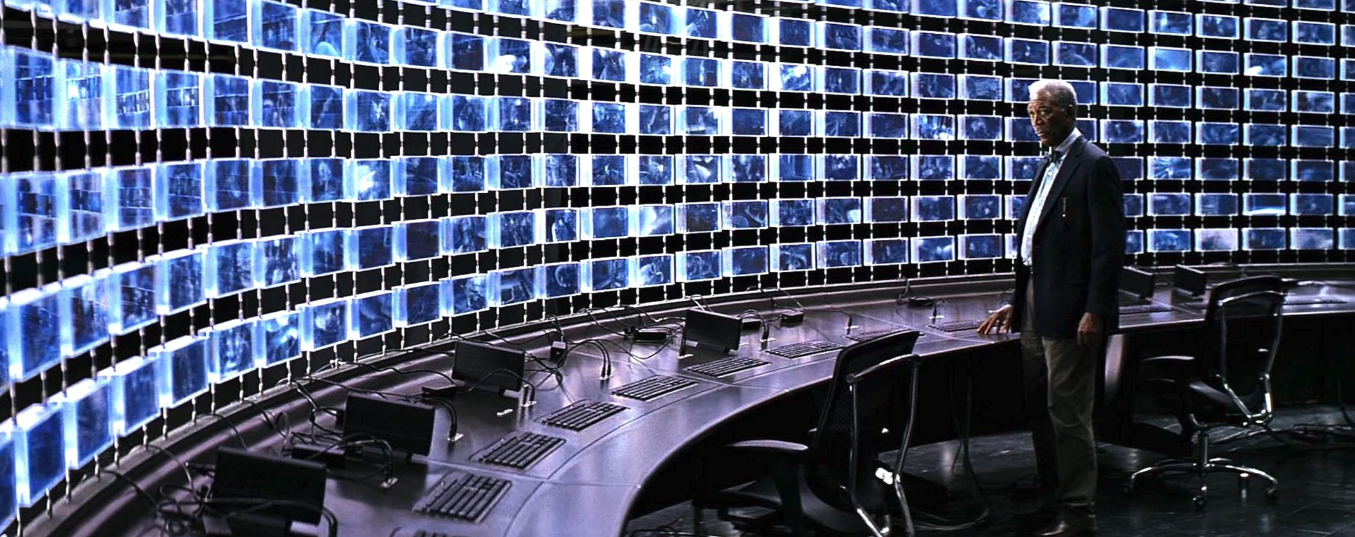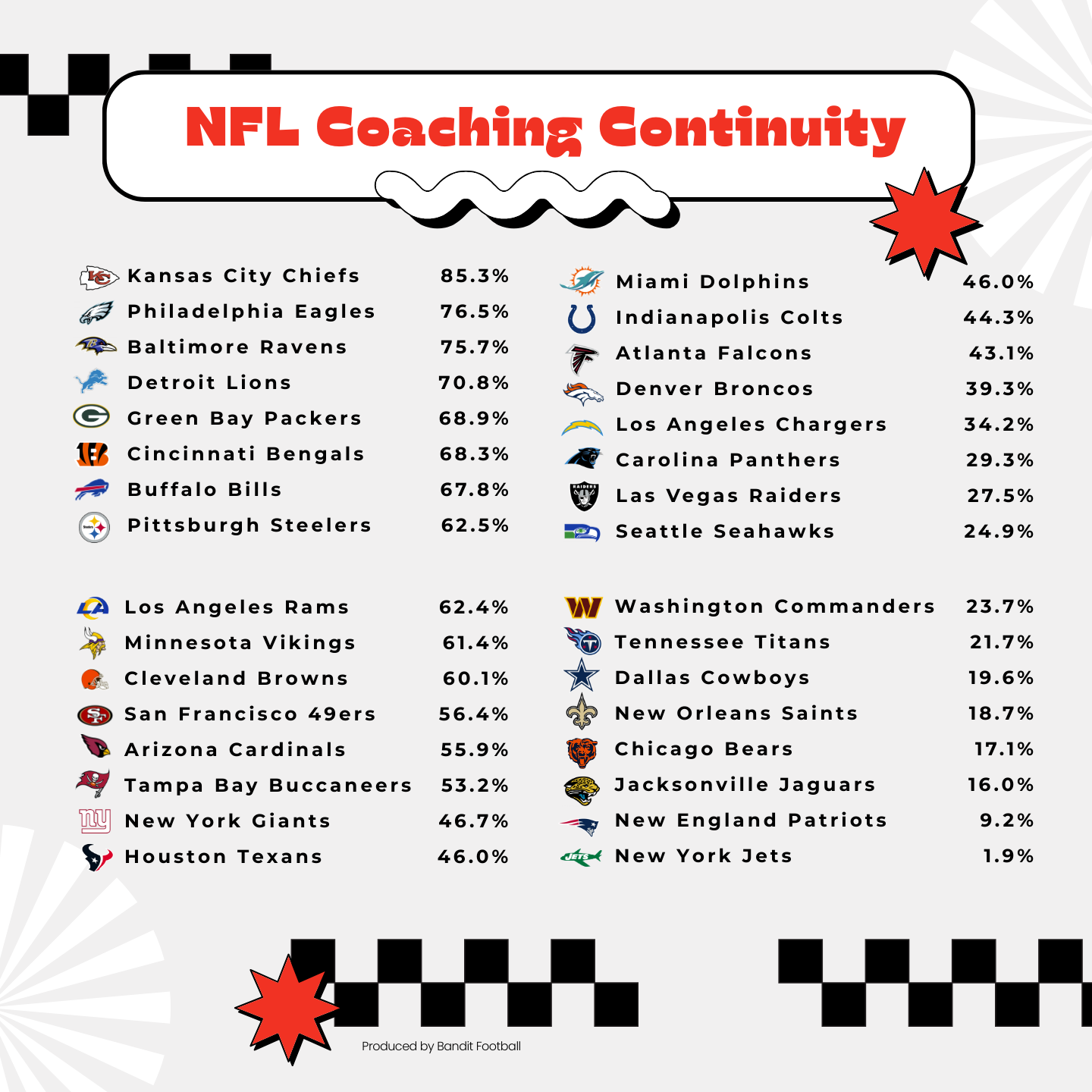NFL Coaching Continuity
Coaching might be the single biggest competitive advantage NFL teams can exploit during the salary-cap era.

Here's where I'm at in building out an extensive coaching tree for all the sickos.
It's still in the sapling stage but the goal is to grow an evergreen so big and tall that Rockefeller Center comes calling around Christmas Future.
I went to each NFL team's website, toggled to their coaching page, and went to work compiling a timeline of the coaches' previous stops over the past three seasons.
I quickly learned that I would need to establish a few guardrails if I was going to come up with any sort of viable formula to assess coaching continuity at a glance.
Guardrails
- Stick to the coaches page: NFL team websites, like NCAA team websites, are all built on the same basic template, where the bones are the same but the teams fill them up however they see fit.
Some teams list their strength and conditioning staff as coaches, others do not. I decided to reward the teams who list as many coaches as possible on said pages because, in essence, it's better than being one of the teams that does not.
Coach X could easily visit another team's page and see someone of similar standing listed while they remained a "relative ghost" in their organization, at least from a front-facing perspective on the team website.
- Only current team continuity: There are several instances of a team bundling their new coaching hires: Coordinator Y is hired with a few positional coaches from their previous stop. Although that group of coaches has inherent continuity, it's not included in the calculation as they are part of a new coaching ecosystem and building that has to learn how to work with one another.
- Only consecutive season continuity: If a coach returns to a franchise after time away, they do not get credit for their previous tenure as the organization as whole has changed since they've been gone.
Before I get to the coaching continuity formula, though, you might be wondering why. What is the point of this, exactly? Why does this matter?
Why Coaching Continuity Matters
Coaching might be the single biggest competitive advantage NFL teams can exploit during the salary-cap era.
Identifying and retaining coaching talent isn't restricted by the salary cap; it makes sense to keep your best teachers as long as they're happy with their role and contributing to the organization.
Sometimes, better opportunities are only available elsewhere. The Lions lost both coordinators to head-coaching jobs this offseason. Several position coaches went with them, which left Detroit with holes to fill on their coaching staff. One of the new faces in Allen Park is running backs coach Tashard Choice, who had a preexisting relationship with star RB Jahmyr Gibbs.
"We've been close since I was 16 or 17. It's crazy because I'm 23 now and we just ended up together," Gibbs told ESPN. "It's really great having a familiar face. Usually when you get new coaches, it's somebody you don't know, so I didn't want to have to relearn that dude."
It's great the Lions were able to tap into that inherent continuity for Gibbs, but still: the rest of the building is having to learn that dude — just as they're having to learn many new personalities around the building this season.
Introducing new coaches to an established building takes time. How will they respond in certain situations? What about when the team's on a losing streak? Will they take their foot off the gas if everything's going great? If everything seems fine?
Think about when there's a new hire on your team. There's a tendency for them to want to go above and beyond, to prove they belong, but everyone else is busy doing their established tasks. Veteran employees don't necessarily have the time or energy to respond to constant inquiries or to check the rookie's work. They need to stay on schedule and not disrupt the organization's routine workflow.
Take training camp for example. Here's an excerpt from the Student of the Game podcast about the level of detail coaches put into planning practice and meeting time. Teams micro-schedule their installs and film study down to the minute, working backwards in 5- or 10-minute blocks to get their plays down on the grass and reviewed on film before their next practice.
How much time do we have to rep the techniques? That's how much we can put in that day. So if we've got 20 minutes of routes on air, then we can probably put in two pass concepts that day, because we're going to run them for 10 minutes each on air.
This illustrates how crucial it is for an entire coaching staff to be on the same page, as there isn't enough time to stray off the practice script if you want to have enough plays you feel comfortable running on game day. The longer a coaching staff remains together, the easier and quicker the process becomes.
There's a bit in the book Collision Low Crossers when Jets head coach Rex Ryan takes over defensive playcalling from coordinator Mike Pettine, but Pettine maintains his role as a governor on game day. Ryan was more of an improviser, a freewheeling playcaller who liked to act on feel, but Pettine was there to remind him in the headset, "Rex, we didn't rep that play in practice, we can't run that coverage."
Some coaches take extreme measures to make sure their staff and players stick to the script, that everyone is on the same page, that the meetings stay on task and everything is being taught correctly.
Kyle Shanahan likes to watch:
In 2020, COVID protocols forced teams to update their video technology and make every meeting virtually accessible. When players and coaches were allowed to meet in person again, Kyle kept using the Zoom feature. Now, he can speak in a meeting room from his own office simply by unmuting himself. If he’s not physically in the room, he can be listening in — and he pays close attention to the quarterbacks.
“We always call that screen in our room the voice of God,” said third-string quarterback Brandon Allen.
“His voice just comes in from heaven,” said run game coordinator and offensive line coach Chris Foerster.
“We’d be talking about something, and he’d unmute and say, ‘Actually, you read it this way,’ and then he would mute again,” said quarterback Nate Sudfeld, who played for San Francisco in 2021. “So you gotta be careful what you say.”

There's only so much the coaching staff can do to prepare players each week to get ready for their next opponent in season. That's why OTAs, mandatory minicamp, training camp and the preseason are so vital to each team's success.
As Marlon Humphrey put it to Kevin Clark:
You know it will be a completely different team. It doesn't matter even if you have almost everybody coming back, just the vibe of the team — it always changes. You can't do the same thing you did last year and have the same success.
Of course, most teams don't have everybody coming back. Mike McDaniel has the raw data on how much turnover effects teams each season.
“Forty-five percent of the roster is different every year across the league. You have to create a team, and how do you create a team in a year with half the (roster) being different? Crucial player accountability through the locker room is a competitive advantage if you can (get it).
He's not kidding. Teams put a great deal of effort into planning out locker room assignments to foster team chemistry.
Rams coach Sean McVay said he typically lets Brendan Burger, the team's senior director of equipment, assign lockers, because "he's got such a good feel." McVay is not a believer in keeping the offensive players in one place and the defenders elsewhere.
"So much of the days are broken up where it's offense-defense separate, and to just be able to create that natural interaction and appreciation for each other – not exclusive to just one side of the ball – that's kind of what goes into it," McVay said.
However, most teams — including the Rams — don't list their equipment managers on their coaches page.
Coaching Continuity Formula
- 25% Head Coach
- 15% Offensive Coordinator
- 15% Defensive Coordinator
- 15% Special Teams Coordinator
- 10% Offensive assistants
- 10% Defensive assistants
- 5% Strength and Conditioning staff
- 5% Remainder
My formula would be different than your formula or their formula, but the important thing is that it was applied equally across the board and stuck to the data, washing out bias and opinion.
How important is the head coach? Enough to drop a team to a maximum 75% continuity score if they're a new hire.
All coordinators created equal? All three phases, baby! While there are considerably fewer coaches assigned to special teams, I thought the best course of action was to assign equal weighting to coordinators across the board. However, special teams assistants are lumped into the Remainder (5%) calculation while offensive and defensive assistants are assigned (10%) each.
Remaining strength? Rewarding teams who list their strength or operations staffers as coaches seemed like the right thing to do. Penalizing teams that did not list them on their coaches page seemed unfair, though — after all, we could be talking about an editorial assistant who's in charge of updating a team's website. So, if a team didn't list their strength or operations staff, the most they could be penalized would be 10%. That way, they could still earn a maximum 90% continuity score, which seemed like a fair line to draw.
Weighting
- 2025 New Hire: 0%
- 2024 Sophomore: 25%
- 2023 Junior: 50%
- 2022 Senior: 75%
- 2011-21 Tenured: 100%
- Before 2010: 85%
Sticking to a simple, quarter-based weighting system made the most sense. Rather than trying to do the mental gymnastics of calculating the exact moment 10,000 hours was achieved by a single staff member — especially when several NFL coaches keep longer hours in-season, sometimes even sleeping in the office — this weighting system made the most sense to me and, again, was the easiest way to keep all things equal and fair across the board, ensuring the data was treated fairly without bias and opinion.
Longevity penalty? I made the decision to knock coaches who have been employed by the same team since before the 2010s. They receive an 85% allotment of points instead of the full 100% like coaches who have been with their team for up to 15 seasons. Given the constant churn in the league and possibility for staleness or generational divide, I thought it was warranted. These old-timers outweigh similar coaches entering their fourth season with a club, as their extended tenure is more valuable to continuity on the whole. Replacing a 20+ year coach would cause more waves than replacing one who's been there a few seasons.
How does the calculation look in practice?
Example
Seattle Seahawks Defensive Staff
- Earned continuity score: 7%
Defensive coordinator (3.75%) + Defensive assistants (3.125%) - Out of a potential maximum score: 25%
Defensive coordinator (15%) + Defensive assistants (10%)
Defensive Coordinator Aden Durde (2024) — 3.75%
- 15 percent multiplied by .25 equals 3.75 percent.
Defensive Assistants — 3.125%
Total defensive assistants (8) divided by (10%) = 1.25% per assistant
Decimal points rounded to the nearest tenth for readability
- Asst. HC Leslie Frazier = (0.3%)
- Def. Pass Game Coord. / DBs Karl Scott = (0.9%)
- Outside LBs Chris Partridge = (0.3%)
- Inside LBs Kirk Olivadotti = (0.3%)
- Safeties Jeff Howard = (0.3%)
- DL Justin Hinds= (0.3%)
- Def. Asst. / LBs Josh Bynes = (0.3%)
- Def. Intern Rob Caprice = (0.3%)
2025 NFL Coaching Continuity Results

- Kansas City Chiefs — 85.3%
- Philadelphia Eagles — 76.5%
- Baltimore Ravens — 75.7%
- Detroit Lions — 70.8%
- Green Bay Packers — 68.9%
- Cincinnati Bengals — 68.3%
- Buffalo Bills — 67.8%
- Pittsburgh Steelers — 62.5%
- Los Angeles Rams — 62.4%
- Minnesota Vikings — 61.4%
- Cleveland Browns — 60.1%
- San Francisco 49ers — 56.4%
- Arizona Cardinals — 55.9%
- Tampa Bay Buccaneers — 53.2%
- New York Giants — 46.7%
- Houston Texans — 46.0%
- Miami Dolphins — 46.0%
- Indianapolis Colts — 44.3%
- Atlanta Falcons — 43.1%
- Denver Broncos — 39.3%
- Los Angeles Chargers — 34.2%
- Carolina Panthers — 29.3%
- Las Vegas Raiders — 27.5%
- Seattle Seahawks — 24.9%
- Washington Commanders — 23.7%
- Tennessee Titans — 21.7%
- Dallas Cowboys — 19.6%
- New Orleans Saints — 18.7%
- Chicago Bears — 17.1%
- Jacksonville Jaguars — 16.0%
- New England Patriots — 9.2%
- New York Jets — 1.9%
Sources
- Alex Katson's Patreon: https://www.patreon.com/alexkatson
- New Lions RBs coach Tashard Choice isn't new to Jahmyr Gibbs https://www.espn.com/nfl/story/_/id/45909474/new-detroit-lions-rbs-coach-tashard-choice-isnt-new-jahmyr-gibbs
- Student of the Game podcast: https://podcasts.apple.com/us/podcast/student-of-the-game-building-offenses-and-coaching/id1216363733?i=1000717902214
- Collision Low Crossers book: https://archive.org/details/collisionlowcros0000dawi_j2r8
- "In the 49ers building, Kyle Shanahan is always watching: ‘It’s like Big Brother’": https://www.nytimes.com/athletic/5255088/2024/02/07/49ers-kyle-shanahan-team-meeting-cameras-facility/
- This Is Football podcast: https://podcasts.apple.com/us/podcast/this-is-football-with-kevin-clark/id1705487719?i=1000716886681
- "Inside Mike McDaniel’s vision for turning around Dolphins: ‘Everyone is depending on me’": https://www.nytimes.com/athletic/6551111/2025/08/14/dolphins-mike-mcdaniel-culture/
- "Inside the strategy of organizing an NFL locker room": https://www.espn.com/nfl/story/_/id/45946731/nfl-locker-room-49ers-rams-bengals-falcons-michael-penix-jessie-bates
